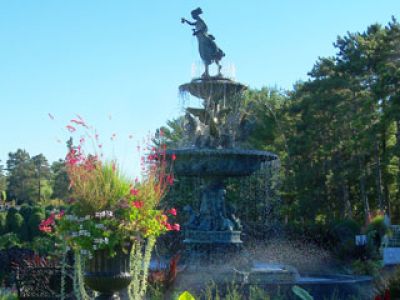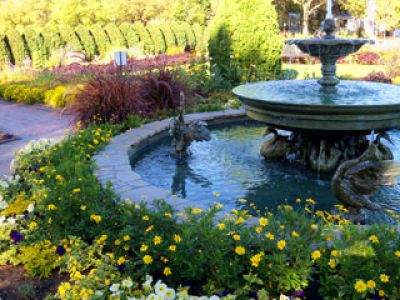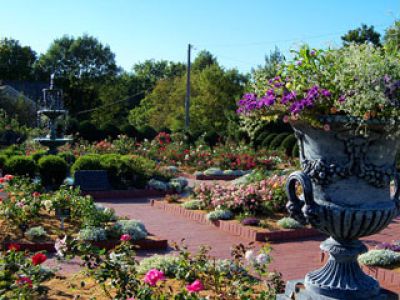Clemens Gardens
When a plot of land came up for sale across Kilian Blvd. from the home of Bill and Virginia Clemens, they purchased it and donated the land to the City of St. Cloud Parks Department. In 1990, Bill Clemens funded the construction of the Virginia Clemens Rose Garden in honor of his wife. Virginia Clemens loved roses and flowers and battled multiple sclerosis for many years. She enjoyed frequent visits and could see the Rose Garden from her window. Today the Rose Garden includes a memorial statue of Bill and Virginia Clemens, close to the Rose Garden they both loved.
In the 1990’s Clemens Gardens began its expansion east from the Rose Garden. A large additional donation from the Clemens family made the expansion possible. In contrast to the informal meandering paths of Munsinger Gardens, Clemens Gardens has a formal design that encourages visitors to enjoy six separate garden areas that make up the whole garden. Clemens Gardens has formal red brick paths, extensive ironwork fencing, urns and benches as well as some beautiful fountains. As the years have passed, trees and shrubs have grown to frame each area of the garden and the flowers in each garden are chosen just for that location.

Virginia Clemens Rose Garden
The centerpiece of the Rose Garden is the large collection of hybrid tea, floribunda, grandiflora and mini roses that are planted in the central quadrants of the garden, around the fountain. Shrub roses are planted around the perimeter of the garden and by the benches and the Clemens Memorial.
Over the years, two test gardens have been added to learn more about roses that should grow well in our climate. If you love roses, this is the place to visit. Roses are labeled, so you can make a note of your favorites.

Rest Area Garden
As you walk down the red brick path to the east you will see the Renaissance Fountain with Cranes. It is one of the tallest outdoor fountains in Minnesota. Nearby is a building with a gift shop, restrooms and a shady deck to take a rest. This area has full sun and is planted with sun loving annuals with colorful flowers and foliage. The colors and design change every year.

Formal Garden
Continue past the Renaissance fountain and the arborvitae hedge and you will enter the Formal Garden. It features geometrical paths and a uniform design of flowers. Again, the design and color scheme changes each year, but the goal of having a neat formal design is always important and gives this garden its special look. In the center of the Formal Garden, you will find the Windsor Court Fountain, a low structure with bathing swans.

White Garden
This garden was inspired by the famous white garden at Sissinghurst Castle in Kent, England. The plants used are different than in England, but the effect of white flowers and green or gray foliage is very soothing on a hot day. The White Garden has an “enclosed” feel. The entrances and corners are marked by stunning urns that overflow with a mix of lovely white flowers..

Perennial Garden
This Garden features an exuberant planting of cold hardy perennials that can survive in our tough Minnesota winters. Each time you visit, the garden will look different as seasons change and spring blooming plants are done and summer and fall bloomers put on their show. This garden contains a mixture of perennial cultivars, native plants and grasses so it is especially attractive to bees and butterflies. In the center of the garden is a twelve-foot replica of a pre-Civil War fountain patterned after one in Columbus, Georgia.

Treillage Garden
At the east end of the Gardens, go up the stairs and see the Arbor. It is 104 feet long and has a central dome that is 24 feet high. Under the dome is the Three Graces Fountain. Be sure to check out the view from up here.
Surrounding the arbor are four gardens that feature gardens of one color. The Yellow garden is a bright combination of perennials and annuals that bloom all year. The Blue garden can be a challenge – true blue flowers are harder to find. There are also Red and Purple gardens. The challenge for monochromatic gardens is to find perennials and shrubs that fit into the color scheme as well as annuals that will bloom all season. To keep things interesting for visitors, the garden design will often use new varieties of annuals each year.